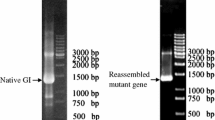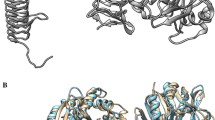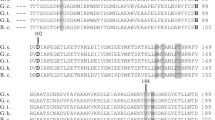Abstract
The role of residue 219 in the physicochemical properties of d-glucose isomerase from Streptomyces sp. SK strain (SKGI) was investigated by site-directed mutagenesis and structural studies. Mutants G219A, G219N, and G219F were generated and characterized. Comparative studies of their physicochemical properties with those of the wild-type enzyme highlighted that mutant G219A displayed increased specific activity and thermal stability compared to that of the wild-type enzyme, while for G219N and G219F, these properties were considerably decreased. A double mutant, SKGI F53L/G219A, displayed a higher optimal temperature and a higher catalytic efficiency than both the G219A mutant and the wild-type enzyme and showed a half-life time of about 150 min at 85 °C as compared to 50 min for wild-type SKGI. Crystal structures of SKGI wild-type and G219A enzymes were solved to 1.73 and 2.15 Å, respectively, and showed that the polypeptide chain folds into two structural domains. The larger domain consists of a (β/α)8 unit, and the smaller domain forms a loop of α helices. Detailed analyses of the three-dimensional structures highlighted minor but important changes in the active site region as compared to that of the wild-type enzyme leading to a displacement of both metal ions, and in particular that in site M2. The structural analyses moreover revealed how the substitution of G219 by an alanine plays a crucial role in improving the thermostability of the mutant enzyme.





Similar content being viewed by others
References
Ben Hlima H, Aghajari N, Ben Ali M, Haser R, Bejar S (2012) Engineered glucose isomerase from Streptomyces sp. SK is resistant to Ca2+ inhibition and Co2+ independent. J Ind Microbiol Biotechnol 39:537–546
Bhosale SH, Rao MB, Deshpande VV (1996) Molecular and industrial aspects of glucose isomerase. Microbiol Rev 60:280–300
Borgi MA, Srih-Belguith K, Ben Ali M, Mezghani M, Tranier M, Haser R, Bejar S (2004) Glucose isomerase of the Streptomyces sp. SK strain: purification, sequence analysis and implication of alanine 103 residue on the enzyme thermostability and acidotolerance. Biochimie 86:561–568
Borgi MA, Rhimi M, Bejar S (2007) Involvement of alanine 103 residue in kinetic and physicochemical properties of glucose isomerases from Streptomyces species. Biotechnol J 2:1–6
Borgi MA, Rhimi M, Aghajari N, Ben Ali M, Juy M, Haser R, Bejar S (2009) Involvement of cysteine 306 and alanine 63 in the thermostability and oligomeric organization of glucose isomerase from Streptomyces sp. SK. Biologia 64:845–851
Bradford MM (1976) A rapid and sensitive method for the quantification of microgram quantities of protein utilizing the principal of protein-dye binding. Anal Biochem 72:248–254
Brünger AT, Adams PD, Rice LM (1998) Recent developments for the efficient crystallographic refinement of macromolecular structures. Curr Opin Struct Biol 8:606–611
Chang C, Park BC, Lee D, Suh SW (1999) Crystal sructures of thermostable xylose isomerases from Thermus caldophilus and Thermus thermophilus: possible structural determinants of thermostability. J Mol Biol 288:623–634
Collyer CA, Henrick K, Blow DM (1990) Mechanism for aldose-ketose interconversion by D-xylose isomerase involving ring-opening followed by a 1,2-hydride shift. J Mol Biol 212:211–235
Dauter Z, Terry H, Witzel H, Wilson K (1990) Refinement of glucose isomerase from Streptomyces albus at 1.65 Å with data from an imaging plate. Acta Crystallogr Sect B: Struct Sci 46:833–841
Dische Z, Borenfreund E (1951) A new spectrophotometric method for the detection and determination of keto sugars and trioses. J Biol Chem 192:583–587
Gerczei T, Böcskei Z, Szabó E, Asboth B, Naray-Szabo G (1999) Structure determination and refinement of the Al3+ complex of the D254,256E mutant of Arthrobacter D-xylose isomerase at 2.40 Å, resolution. Further evidence for inhibitor-induced metal ion movement. Int J Biol Macromol 25:329–336
Harding MM (2001) Geometry of metal-ligand interactions in proteins. Acta Crystallogr sect D: Biol Crystallogr 57:401–411
Henrick K, Collyer CA, Blow DM (1989) Structures of D-xylose isomerase from Arthrobacter strain B3728 containing the inhibitors xylitol and D-sorbitol at 2.5 and 2.3 Å resolution, respectively. J Mol Biol 208:129–157
Jenkins J, Janin J, Rey F, Chiadmi M, van Tilbeurgh H, Lasters I, De Maeyer M, van Belle D, Wodak SJ, Lauwereys M (1992) Protein engineering of xylose (glucose) isomerase from Actinoplanes missouriensis. Crystallography and site-directed mutagenesis of metal binding sites. Biochemistry 31:5449–5458
Kabsch W (1993) Automatic processing of rotation diffraction data from crystals of initially unknown symmetry and cell constants. J Appl Cryst 26:795–800
Katz AK, Li X, Carrell HL, Hanson BL, Langan P, Coates L, Schoenborn BP, Glusker JP, Bunick GJ (2006) Locating active-site hydrogen atoms in D-xylose isomerase: time of-flight neutron diffraction. Proc Natl Acad Sci U S A 103:8342–8347
Kovalevsky AY, Katz AK, Carrell HL, Hanson L, Mustyakimov M, Fisher SZ, Coates L, Schoenborn BP, Bunick GJ, Glusker JP, Langan P (2008) Hydrogen location in stages of an enzyme-catalyzed reaction: time-of-flight neutron structure of D-xylose isomerase with bound D-xylulose. Biochemistry 47:7595–7597
Kovalevsky AY, Hanson L, Fisher SZ, Mustyakimov M, Mason SA, Forsyth VT, Blakeley MP, Keen DA, Wagner T, Carrell HL, Katz AK, Glusker JP, Langan P (2010) Metal ion roles and the movement of hydrogen during reaction catalyzed by d-xylose isomerase: a joint x-ray and neutron diffraction study. Structure 18:688–699
Kozak M (2005) Direct comparison of the crystal and solution structure of glucose/xylose isomerase from Streptomyces rubiginosus. Protein Pept Lett 12:547–550
Kozak M, Taube M (2009) SAXS–WAXS studies of the low-resolution structure in solution of xylose/glucose isomerase from Streptomyces rubiginosus. Radiat Phys Chem 78:125–128
Laemmli UK (1970) Cleavage of structural proteins during the assembly of the head of bacteriophage T4. Nature 227:680–685
Laskowski RA, MacArthur MW, Moss DS, Thornton JM (1993) PROCHECK: a program to check the stereochemical quality of protein structures. J Appl Crystallogr 26:283–292
Long F, Vagin A, Young P, Murshudov GN (2008) BALBES: a molecular replacement pipeline. Acta Cryst 64:125–132
Meilleur F, Snell EH, van der Woerd MJ, Judge RA, Myles DAA (2006) A quasi-Laue neutron crystallographic study of D-xylose isomerase. Eur Biophys J 35:601–609
Murshudov GN, Vagin AA, Dodson EJ (1997) Refinement of macromolecular structures by the maximum-likelihood method. Acta Cryst 53:240–255
Rasmussen H, Lacour T, Nyborg J, Schulein M (1994) Structure determination of glucose-isomerase from Streptomyces murinus at 2.6 Å resolution. Acta Crystallogr Sect D: Biol Crystallogr 50:124–131
Roussel A, Cambillau C (1992) TURBO-FRODO, Biographics. AFMB, Marseille
Sambrook J, Fritsh EF, Maniatis T (1989) Molecular cloning: a laboratory manual, 2nd edn. Cold Spring Harbor Laboratory Press, New York, pp 23–38
Santa H, Kammonen J, Lehtonenb O, Karimaki J, Pastinen O, Leisola M, Turunen O (2005) Stochastic boundary molecular dynamics simulation of L-ribose in the active site of Actinoplanes missouriensis xylose isomerase and its Val135Asn mutant with improved reaction rate. Biochim Biophys Acta 1749:65–73
Srih-Belghith K, Bejar S (1998) A thermostable glucose isomerase having a relatively low optimum pH: study of activity and molecular cloning of the corresponding gene. Biotechnol Lett 20:553–556
Srih-Belghith K, Ellouz R, Bejar S (2002) Polypeptides having glucose isomerase activity and acids encoding the same. (US Patent No: 6, 372, 476)
Toteva MM, Salvaggi NR, Allen KN, Richard JP (2011) Binding energy and catalysis by D-xylose isomerase: kinetic, product, and X-ray crystallographic analysis of enzyme-catalyzed isomerization of (R)-glyceraldehyde. Biochemistry 50:10170–10181
Zhu XY, Teng MK, Niu LW, Xu C, Wang YZ (2000) Structure of xylose isomerase from Streptomyces diastaticus No. 7 strain M1033 at 1.85 Å resolution. Acta Crystallogr Sect D: Biol Crystallogr 56:129–136
Acknowledgments
This work was funded by the Tunisian Ministry of Higher Education, the French–Tunisian CMCU programme no. 09 G 0801, and the French National Research Center (CNRS).
Author information
Authors and Affiliations
Corresponding author
Rights and permissions
About this article
Cite this article
Ben Hlima, H., Bejar, S., Riguet, J. et al. Identification of critical residues for the activity and thermostability of Streptomyces sp. SK glucose isomerase. Appl Microbiol Biotechnol 97, 9715–9726 (2013). https://doi.org/10.1007/s00253-013-4784-2
Received:
Revised:
Accepted:
Published:
Issue Date:
DOI: https://doi.org/10.1007/s00253-013-4784-2




